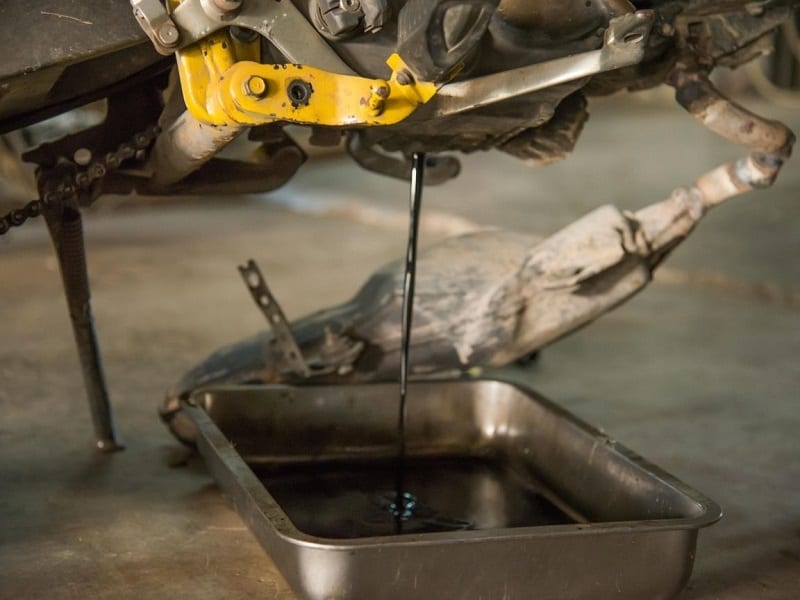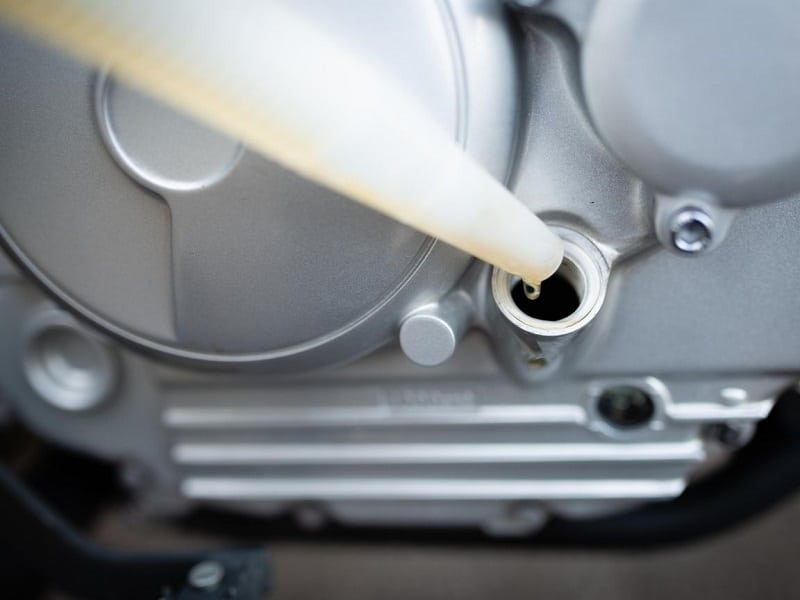Have you ever changed the oil on your motorcycle and when you checked the oil level afterward it was too high? Or you’ve had the bike serviced, and realized the oil level is above the full mark when you got home? We all know that riding a motorcycle with too little oil can be disastrous, but how bad can too much oil be for my motorcycle?
Overfilling a motorcycle with too much oil may cause oil to be pushed out the breather hose into the air box. The excess oil can be sucked into the intake and combusted or it may clog the air filter. Way too much oil in a wet sump can have more serious consequences if the crank hits the surface of of the oil.
Riding a motorcycle with too little oil can cause very serious engine failure. Too much oil in a motorcycle engine can be just as disastrous, but it depends on the type of oil system your bike has as well as the quantity of excess oil. Read on to find out what could happen and what you can do to fix the situation.
What Happens When I Put Too Much Oil in My Motorcycle?
It is obviously ideal to fill your motorcycle engine so that the level is exactly on the maximum mark. If you didn’t drain the oil completely or you don’t know the exact quantity of oil required, it is easy to overfill it. A few ounces of extra oil won’t make a difference, but if you overfill it by a quart or more the situation could be more serious.
If the oil level is way too high the excess oil will gargle out through the breather, usually into the air box. The reason the crank case is vented to the air box is to allow the pressure inside the crank case to equalize and the expelled air to recirculate through the engine.
Sucking oil into the air box is not the end of the world. You may notice oil dripping out your air box (where the air filter lives) and some of this oil may be sucked back into the air intake. This oil will end up in the combustion chamber where it will be burned and foul up your spark plug. You may notice light blue smoke from your exhaust if this is happening. The oil may also clog your air filter if it is completely saturated and cause a lot of power due to the restricted air flow.
If the one-way valve (or PCV valve) on the crank case is clogged, the excess oil may not be able to escape. Built-up pressure won’t either, which could cause your output shaft seal to start leaking. Depending on the design of you bike, oil could drip on your clutch and cause it to slip.
None of these consequences are too serious if attended to quickly, but a more serious condition could occur. If your motorcycle has a wet sump system where the oil drains to an oil sump below the crank case, the oil sump level can be too high which may cause the bottom end of the crank to hit the surface of the oil at a very high speed.
The sump is baffled to prevent oil from reaching the crank when you accelerate or brake and the oil starts sloshing around. But with too much oil in the engine, the baffling may not be effective. If oil reaches the crank it will start whipping the oil which will cause the oil to foam and lose its viscosity. The oil pressure may drop and it will result in a lot of heat being generated. once this happens, the oil galleries could be starved of oil and your engine could seize for the same reasons as too little oil in the engine.
What to Do if You Overfilled Your Bike With Oil
Don’t panic. It is done. Read on and start fixing the problem.
If you’ve not run the engine
If you notice that your oil level is too high, either in the glass inspection window or the dipstick, drain a little of the excess oil. This is a messy business since you have to unscrew the drain plug enough for oil to seep out, but not all the way. It will flow over your hands or tools, so be ready with lots of paper towels and a drain pan.
Don’t drop the drain plug and if you’ve already run the engine until hot, don’t burn yourself!
If you have run the engine
If you’ve run the engine for more than a few minutes with the excess oil, and the oil that comes out when you drain it is foamy or has lots of bubbles, your crank may have started to whip the oil. Rather drain all the oil and replace it with fresh oil. You don’t want to risk running your engine with oil that has lost its lubricating properties.

Inspect the air filter. It it is saturated in oil, replace it with a new filter and wipe the air box clean with a rag or paper towels. Take the time to remove the spark plugs to see if they have fouled up. If the tips are wet with oil, you’ve been burning it. Either clean the plugs with parts cleaner or replace them.
Don’t over tighten the sump plug, as you can strip the treads. Just tighten it until it is snug and check for oil leaks once you’ve cleaned up the mess. If it still drips after riding a few miles, tighten it just a teeny bit more.
TIP: I haven’t tried this, but someone suggested using the top of a spray bottle, sticking the straw end in the oil filler hole and spraying the excess out. This could work if you can reach the oil. You could also try a turkey baster.
If your clutch is slipping because some oil dripped onto it, it should clear up on its own after a while. The friction will burn off the oil. A bigger concern is that there is a compromised seal that caused the leak. This will have to be replaced by a mechanic.
How to Prevent Overfilling Your Motorcycle with Oil
If you change your own oil, follow these steps to make sure you don’t overfill it again.
Step 1: Warm up the engine
Run the engine for 15 minutes to warm up the oil. It will flow more easily, and will drain quicker and more completely.
Step 2: Make sure about the quantity
Look up the quantity of oil that you motorcycle takes. The owner’s manual that came with the bike is the only source you should trust 100%, but for most popular bikes you will be able to find the quantity online.

If you want to make sure, measure the exact quantity according to manual in a separate container. It can be difficult to know by looking on the side of a gallon oil can.
Step 3: Undershoot a little and check
I always pour in a few ounces less than the specified quantity and check the oil level first. Make sure in the owner’s manual whether your bike needs to be on the side stand or upright when reading the oil level. Also check whether the engine should be hot or not.
On my old KLR 650 the engine had to be at operating temperature and you had to wait a few minutes before checking the oil level with the bike upright. Any deviation would show an incorrect reading.
Step 4: Add more oil until just right
Once you’ve rechecked the oil level on your motorcycle again, you can add a little oil at a time until it is just right. The few extra minutes it takes to do it right will give you peace of mind.
Conclusion
If you notice that your motorcycle engine has too much oil in it, don’t panic. Just follow the steps below to drain a little oil out. Also take some time to check the air filter and spark plugs. If you don’t see any leaks after you’ve cleaned up the mess, stop worrying about it. Next time, make sure to hit that maximum mark exactly.
Related Questions
Filled your Gas Tank With Diesel?
If you want to find out what will happen if you accidentally filled your motorcycle gas tank with diesel, as well as what you can do to fix it, read this post.
